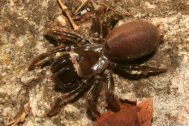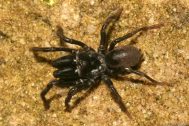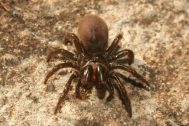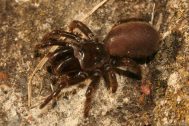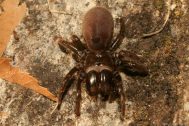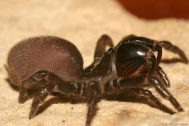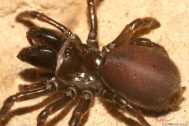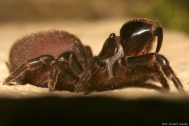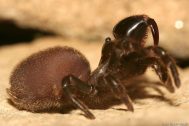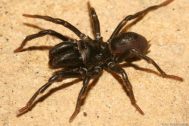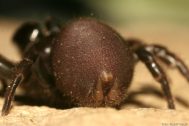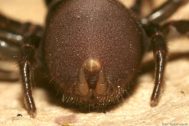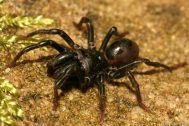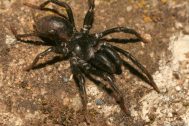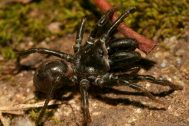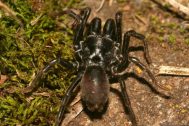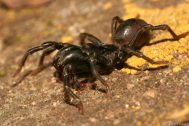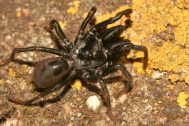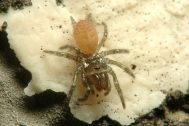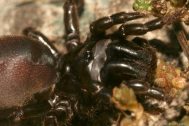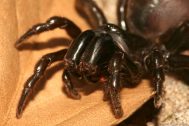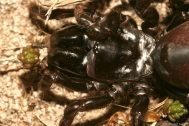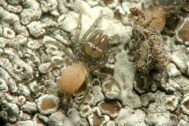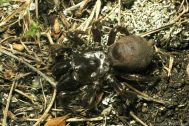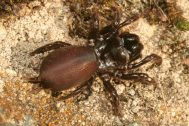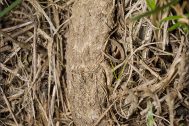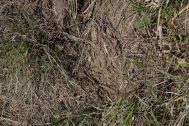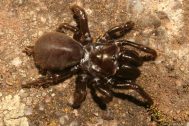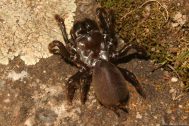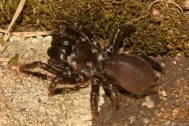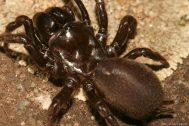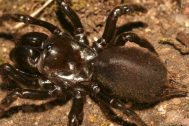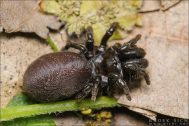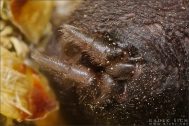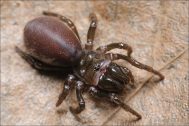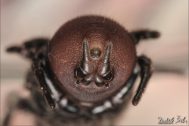| Records by time | |||||
|---|---|---|---|---|---|
| Atypidae | 0-1900 | 1901-1950 | 1951-2000 | 2001+ | ∑ |
 Atypus affinis
Eichwald, 1830 Almost threatened Atypus affinis
Eichwald, 1830 Almost threatened |
4× | 163× | 58× | 225× | |
 Atypus muralis
Bertkau, 1890 Strongly endangered Atypus muralis
Bertkau, 1890 Strongly endangered |
1× | 6× | 51× | 26× | 84× |
 Atypus piceus
(Sulzer, 1776) Endangered Atypus piceus
(Sulzer, 1776) Endangered |
5× | 93× | 46× | 144× | |
Bibliography
Four spider species (Araneae: Atypidae, Theridiidae, Linyphiidae) new for the Bohemian Forest, Czech Republic
During an araneological survey in the Šumava Protected Landscape Area and National Park in 2020, four spider species were discovered for the first time in the Bohemian Forest: Atypus affinis (Atypidae), Achaeridion conigerum and Phycosoma inornatum (Theridiidae), and Gongylidiellum edentatum (Linyphiidae). All species were collected at the vicinity of Rejštejn and are considered least concern (LC), critically endangered (CR) and vulnerable (VU), respectively. Along with the four species, lists of accompanying species from respective localities are provided.Výsledky faunistického průzkumu pavouků a sekáčů na vybraných lokalitách na území NP Podyjí v roce 2019
A total of 114 spider species from 25 families and one harvestmen species were found during the zoological research at several sites in the Podyjí National Park during 2019. Of them, forty-one species are listed in the Red List of spiders of the Czech Republic. Four new species for the Podyjí NP were recorded – Callilepis nocturna (Linnaeus, 1758), Euryopis laeta (Westring, 1861), Phrurolithus minimus C. L. Koch, 1839 and Trichoncus auritus (L. Koch, 1869). Among the most interesting species, four critically endangered spiders – Civizelotes caucasius (L. Koch, 1866), Phrurolithus szilyi Herman, 1879, Gnaphosa modestior Kulczyński, 1897 and Eresus moravicus Řezáč, 2008 should be mentioned. Other rare species include Acartauchenius scurrilis (O. Pickard-Cambridge, 1873), Agyneta fuscipalpa (C. L. Koch, 1836), Arctosa figurata (Simon, 1876), Atypus affinis Eichwald, 1830, Bassaniodes robustus (Hahn, 1832), Callilepis schuszteri (Herman, 1879), Centromerus incilium (L. Koch, 1881), Centromerus leruthi Fage, 1933, Cheiracanthium effossum Herman, 1879, Drassyllus villicus (Thorell, 1875), Euryopis quinqueguttata Thorell, 1875, Frontinellina frutetorum (C. L. Koch, 1835), Gibbaranea gibbosa (Walckenaer, 1802), Gnaphosa opaca Herman, 1879, Haplodrassus cognatus (Westring, 1861), Haplodrassus dalmatensis (L. Koch, 1866), Haplodrassus minor (O. Pickard-Cambridge, 1879), Heterotheridion nigrovariegatum (Simon, 1873), Kishidaia conspicua (L. Koch, 1866), Leptorchestes berolinensis (C. L. Koch, 1846), Minicia marginella (Wider, 1834), Phrurolithus pullatus Kulczyński, 1897, Trichopterna cito (O. Pickard-Cambridge, 1873), Walckenaeria simplex Chyzer, 1894, Zelotes erebeus (Thorell, 1871) and Zora manicata Simon, 1878.Výsledky faunistického průzkumu pavouků a sekáčů na vybraných lokalitách na území NP Podyjí v roce 2019
A total of 114 spider species from 25 families and one harvestmen species were found during the zoological research at several sites in the Podyjí National Park during 2019. Of them, forty-one species are listed in the Red List of spiders of the Czech Republic. Four new species for the Podyjí NP were recorded – Callilepis nocturna (Linnaeus, 1758), Euryopis laeta (Westring, 1861), Phrurolithus minimus C. L. Koch, 1839 and Trichoncus auritus (L. Koch, 1869). Among the most interesting species, four critically endangered spiders – Civizelotes caucasius (L. Koch, 1866), Phrurolithus szilyi Herman, 1879, Gnaphosa modestior Kulczyński, 1897 and Eresus moravicus Řezáč, 2008 should be mentioned. Other rare species include Acartauchenius scurrilis (O. Pickard-Cambridge, 1873), Agyneta fuscipalpa (C. L. Koch, 1836), Arctosa figurata (Simon, 1876), Atypus affinis Eichwald, 1830, Bassaniodes robustus (Hahn, 1832), Callilepis schuszteri (Herman, 1879), Centromerus incilium (L. Koch, 1881), Centromerus leruthi Fage, 1933, Cheiracanthium effossum Herman, 1879, Drassyllus villicus (Thorell, 1875), Euryopis quinqueguttata Thorell, 1875, Frontinellina frutetorum (C. L. Koch, 1835), Gibbaranea gibbosa (Walckenaer, 1802), Gnaphosa opaca Herman, 1879, Haplodrassus cognatus (Westring, 1861), Haplodrassus dalmatensis (L. Koch, 1866), Haplodrassus minor (O. Pickard-Cambridge, 1879), Heterotheridion nigrovariegatum (Simon, 1873), Kishidaia conspicua (L. Koch, 1866), Leptorchestes berolinensis (C. L. Koch, 1846), Minicia marginella (Wider, 1834), Phrurolithus pullatus Kulczyński, 1897, Trichopterna cito (O. Pickard-Cambridge, 1873), Walckenaeria simplex Chyzer, 1894, Zelotes erebeus (Thorell, 1871) and Zora manicata Simon, 1878.Epigeic spiders from oak-hornbeam woodland in the Děvín National Nature Reserve (Czech Republic).
Data on the spider fauna from the forest ecosystems of the Děvín National Nature Reserve (South Moravia, Czech Republic) are presented. The research was carried out on 15 randomly chosen research plots in oak-hornbeam forest stands within different management regimes. Spider sampling was done by pitfall trapping from May to October 2016. Overall, 3683 adult spiders belonging to 22 families, 70 genera and 116 species were collected. The families Linyphiidae, Lycosidae, Gnaphosidae and Thomisidae exhibited high species richness. The most abundant species were Pardosa lugubris (Walckenaer, 1802) and Trochosa terricola Thorell, 1856. Faunistically remarkable species were Atypus piceus (Sulzer, 1776), Drassyllus villicus (Thorell, 1875), Gnaphosa montana (L. Koch, 1866), Panamomops affinis Miller & Kratochvíl, 1939 and Walckenaeria monoceros (Wider, 1834). The record of Gnaphosa montana is one of the first accounts of this psychrophilic spider from European lowlands. Of the identified species, 23 are listed in the Red List of Threatened Species in the Czech Republic (EN – 1 species, VU – 12 species, LC – 10 species).Příspěvek k fauně pavouků vybraných lokalit střední Moravy
Během exkurze České arachnologické společnosti konané 31. 5. – 3. 6. 2018 v CHKO Litovelské Pomoraví a v oblasti Velkého a Malého Kosíře na Prostějovsku bylo nasbíráno 188 druhů pavouků, z nichž 17 je zařazeno mezi ohrožené až kriticky ohrožené druhy. Mezi nejvýznamnější nálezy patří Atypus affinis, Arctosa maculata, Dolomedes fimbriatus,Enoplognatha caricis, Hypsosinga heri nebo Neottiura suaveolens.
Habitat selection by threatened burrowing spiders (Araneae: Atypidae, Eresidae) of central Europe: evidence base for conservation management.
Habitat selection in sedentary, long-lived burrowing spiders is a key life-history event that directly affects their reproductive success. In this study, we analyzed the role of the chemical and physical properties of soil in habitat selection by threatened temperate burrowing spiders. We examined 296 burrows of three Atypus spp. and three Eresus spp. at 68 sites in Czechia. We found that the study species were associated with soils that have high or very high cation exchange capacity, which allows the presence of a stable nd humid microclimate in their burrows. We found that specific bedrock types can be used as predictors of the presence of particular study species. All Eresus spp. avoided compacted soils. However, when present in soils with very low penetration resistance, they were limited to sites with high soil cohesion. The burrows of all study species were located at well-drained sites. The study species seemed to be selective for a steppe-like character of their microhabitat but not necessarily for its southward orientation. We found the study species even at sites where steppes were present in the early 1950s and that underwent later afforestation but not extensive landscaping or plowing. What types of disturbances can be sustained by the study species and how long it takes the decreased populations to recover after, e.g., trampling associated with grazing, remain to be investigated.
Pavouk 42 (7/2017)
Pavouci České republiky; Nový druh třesavky pro území České republiky, aneb další synantrop za dveřmi (nebo před?); Zajímavý nález tropické maloočky v Hranicích na Moravě; Katalogy pavouků a evidence prvonálezů; Snovačka půdní (Steatoda triangulosa) ve volné přírodě v ČR; Poznámka k výskytu listovníků Philodromus margaritatus a P. fuscomarginatus; Nová lokalita sklípkánka hnědého (Atypus affinis); Zoologické dny Brno 2017; Česko-britský arachnologický seminář v Praze; Exkurze Mohelenský mlýn 2017; Arachnologická exkurze Mostecko 2017; Přírodovědecký spolek Arachne; Obsah původního Arachnologického spravodaje v minulosti; Čestní členové České arachnologické společnosti; Arachnologická knihovna Jiřího Bauma; Česká bibliografie 2017; Britská bibliografie – The Newsletter 138; Inventarizace 2016; Pokyny pro autoryPříspěvek k výskytu sklípkánka Atypus muralis Bertkau, 1890 a stepníka Eresus kollari Rossi, 1846 na Prostějovsku.
Příspěvek pojednává o nálezu izolované populace Atypus muralis a Eresus kollari na Prostějovsku.Pavouci kavylové stepi u Brozan v dolním Poohří (severní Čechy).
V letech 2008 a 2010 bylo sledováno společenstvo pavouků (Araneae) sprašové stráně za hřbitovem v katastru obce Brozany nad Ohří (číslo faunistického čtverce 5550, 50°27´43˝N, 14°07´48˝E, 170 m n. m., Obr. 2). Tato lokalita je charakterizovaná jako v rámci Čech unikátní kavylová step na černozemní půdě na sprašové návěji (Řezáč 2009) s typickými xerotermo- filními rostlinnými druhy (Astragalus exscapus, Adonis vernalis, Verbascum phoeniceum, Stipa capillata aj.). Již po několik let je známá výskytem sklípkánků (Atypus sp.). Jejich nory s charakteristickými trubicovitými pavučinovými vyústěními (punčoškami, Obr. 3) zde objevil při botanickém průzkumu lokality Jan Novák a později pravidelně pozoroval Pavel Moravec (in verb.). Dosud nebyl k dispozici žádný dokladový vzorek, avšak Řezáč (2009) předpokládal podle charakteru lokality výskyt sklípkánka pontického, Atypus muralis Bertkau, 1890 (Obr. 4).Ekologická charakteristika araneocenóz Přírodního parku Chlum se zaměřením na fenologii druhu Atypus piceus.
The distribution of purse-web Atypus spiders (Araneae: Mygalomorphae) in central Europeis constrained by microclimatic continentality and soil compactness.
Aim Three species of primitive spiders of the genus Atypus occur in European xerothermic habitats, where they live in burrows. The aim of this study is to explain their distribution by investigating environmental variables at sites where they occur in central Europe.
Location Over 50 sites in central Europe, Czech Republic.
Methods Data on climatic, edaphic and vegetational parameters were collected from more than 50 sites. Phytocenological data were processed using Ellenberg’s indicator values.
Results Atypus muralis was found to occur almost exclusively in dry grassland (Festucion valesiacae), exposed to a continental microclimate. Atypus affinis usually occurred in dry sparse forests (Genisto germanicae–Quercion) that provide an Atlantic microclimate. Atypus piceus occurred in dry grassland (Bromion erecti) or forest fringes (Geranion sanguinei) characterized by an intermediate microclimate. Atypus piceus and Atypus muralis were restricted to agglutinate calcareous soils.
Main conclusions Our results show that Atypus species colonized sites with different continentality in central Europe. These differences correspond to differences among their probable glacial refugia. Atypus muralis and Atypus piceus occur in habitats with a markedly continental climate, and are restricted to calcareous agglutinate soils that more efficiently buffer temperature and humidity extremes. Habitats of Atypus muralis and Atypus piceus are threatened by overgrowth of vegetation after a recent decline in grazing and by the decalcification of the landscape. However, habitats of Atypus affinis are stable in the present central European climate.
Unusual karyotype diversity in the European spiders of the genus Atypus (Araneae: Atypidae).
Compared with araneomorph spiders, karyotypes of the spider infraorder Mygalomorphae are nearly unknown. In this study we investigated karyotypes of European species of the genus Atypus (Atypidae). The male karyotype of Atypus muralis and Atypus piceus comprises 41 chromosomes, whereas female complements contain 42 chromosomes. On the other hand, both sexes of Atypus affinis possess 14 chromosomes only. It is the lowest diploid number found in mygalomorph spiders so far. Furthermore, obtained data suggest X0 sex chromosome system in Atypus piceus, Atypus muralis and neo-XY system in Atypus affinis. Karyotypes of all three Atypus species are composed of biarmed chromosomes only. Thus they differ significantly from the karyotype of A. karschi , the only other species of this genus studied so far. Its karyotype was reported to be composed of acrocentric chromosomes and possesses X1X20 sex chromosome system. All this shows that unlike in most genera of araneomorph spiders, mygalomorphs of the genus Atypus exhibit unusual diversity in the number, morphology of chromosomes, and the sex chromosome system. Considering high number of chromosomes being plesiomorphic character in spiders, then karyotypes of Atypus muralis and Atypus piceus represent ancestral situation and that of Atypus affinis being derived by multiple fusions. Karyotype differences in Atypus correspond with morphological differences, namely the number of segments of the posterior lateral spinnerets. Thus in contrast to published hypothesis, the 3-segmented posterior lateral spinnerets of Atypus affinis should present a derived state.
Gallery
Atypus affinis
Atypus muralis
Atypus piceus
Statistics
By month
By altitude
By collecting method (453 used records)
| Neurčeno | Males | Females | Juveniles | Records |
|---|---|---|---|---|
| Atypus affinis Eichwald, 1830 | 21 | 14 | 5 | 95 |
| Atypus muralis Bertkau, 1890 | 7 | 13 | 0 | 43 |
| Atypus piceus (Sulzer, 1776) | 11 | 11 | 1 | 62 |
| Zemní past | Males | Females | Juveniles | Records |
| Atypus affinis Eichwald, 1830 | 159 | 8 | 10 | 85 |
| Atypus muralis Bertkau, 1890 | 26 | 1 | 2 | 20 |
| Atypus piceus (Sulzer, 1776) | 98 | 4 | 3 | 35 |
| Individuální sběr | Males | Females | Juveniles | Records |
| Atypus affinis Eichwald, 1830 | 5 | 10 | 12 | 24 |
| Atypus muralis Bertkau, 1890 | 4 | 4 | 2 | 13 |
| Atypus piceus (Sulzer, 1776) | 21 | 26 | 5 | 39 |
| Smyk | Males | Females | Juveniles | Records |
| Atypus affinis Eichwald, 1830 | 2 | 1 | 2 | 15 |
| Atypus piceus (Sulzer, 1776) | 0 | 0 | 0 | 2 |
| Prosev | Males | Females | Juveniles | Records |
| Atypus affinis Eichwald, 1830 | 15 | 0 | 1 | 4 |
| Atypus muralis Bertkau, 1890 | 4 | 1 | 0 | 6 |
| Atypus piceus (Sulzer, 1776) | 5 | 2 | 2 | 6 |
| Pozorování | Males | Females | Juveniles | Records |
| Atypus affinis Eichwald, 1830 | 1 | 4 | 0 | 2 |
| Fotografie | Males | Females | Juveniles | Records |
| Atypus muralis Bertkau, 1890 | 0 | 2 | 0 | 2 |
| Males | Females | Juveniles | Records |
By biotope (453 used records)
| Neurčeno | Males | Females | Juveniles | Records |
|---|---|---|---|---|
| Atypus affinis Eichwald, 1830 | 40 | 19 | 18 | 139 |
| Atypus muralis Bertkau, 1890 | 11 | 5 | 0 | 55 |
| Atypus piceus (Sulzer, 1776) | 17 | 20 | 8 | 90 |
| Lesostepní doubravy | Males | Females | Juveniles | Records |
| Atypus affinis Eichwald, 1830 | 45 | 3 | 0 | 15 |
| Atypus muralis Bertkau, 1890 | 5 | 0 | 0 | 5 |
| Atypus piceus (Sulzer, 1776) | 57 | 5 | 1 | 16 |
| Suché louky | Males | Females | Juveniles | Records |
| Atypus affinis Eichwald, 1830 | 18 | 0 | 0 | 8 |
| Atypus muralis Bertkau, 1890 | 4 | 12 | 3 | 8 |
| Atypus piceus (Sulzer, 1776) | 7 | 4 | 2 | 6 |
| Suché doubravy | Males | Females | Juveniles | Records |
| Atypus affinis Eichwald, 1830 | 30 | 8 | 0 | 16 |
| Atypus piceus (Sulzer, 1776) | 13 | 0 | 0 | 5 |
| Skalní stepi na vápenci | Males | Females | Juveniles | Records |
| Atypus affinis Eichwald, 1830 | 3 | 0 | 0 | 3 |
| Atypus muralis Bertkau, 1890 | 16 | 1 | 0 | 11 |
| Atypus piceus (Sulzer, 1776) | 18 | 1 | 0 | 3 |
| Acidofilní bory | Males | Females | Juveniles | Records |
| Atypus affinis Eichwald, 1830 | 22 | 2 | 1 | 13 |
| Atypus piceus (Sulzer, 1776) | 2 | 0 | 0 | 1 |
| Reliktní bory na skalách | Males | Females | Juveniles | Records |
| Atypus affinis Eichwald, 1830 | 29 | 2 | 2 | 12 |
| Atypus piceus (Sulzer, 1776) | 1 | 0 | 0 | 1 |
| Lesní okraje | Males | Females | Juveniles | Records |
| Atypus affinis Eichwald, 1830 | 3 | 0 | 0 | 3 |
| Atypus piceus (Sulzer, 1776) | 1 | 1 | 0 | 3 |
| Xerotermní travinobylinná společenstva | Males | Females | Juveniles | Records |
| Atypus affinis Eichwald, 1830 | 1 | 0 | 0 | 1 |
| Atypus muralis Bertkau, 1890 | 3 | 0 | 1 | 1 |
| Atypus piceus (Sulzer, 1776) | 0 | 6 | 0 | 2 |
| Suché lesní lemy | Males | Females | Juveniles | Records |
| Atypus piceus (Sulzer, 1776) | 8 | 2 | 0 | 4 |
| Porosty borůvek | Males | Females | Juveniles | Records |
| Atypus affinis Eichwald, 1830 | 4 | 1 | 5 | 4 |
| Dubohabřiny | Males | Females | Juveniles | Records |
| Atypus affinis Eichwald, 1830 | 2 | 0 | 0 | 1 |
| Atypus piceus (Sulzer, 1776) | 1 | 0 | 0 | 2 |
| Suťové a roklinové lesy | Males | Females | Juveniles | Records |
| Atypus affinis Eichwald, 1830 | 0 | 1 | 0 | 1 |
| Atypus piceus (Sulzer, 1776) | 0 | 2 | 0 | 2 |
| Výsadby jehličnanů | Males | Females | Juveniles | Records |
| Atypus piceus (Sulzer, 1776) | 6 | 0 | 0 | 3 |
| Kamenité suti nižších poloh | Males | Females | Juveniles | Records |
| Atypus affinis Eichwald, 1830 | 2 | 0 | 0 | 2 |
| Pastviny | Males | Females | Juveniles | Records |
| Atypus piceus (Sulzer, 1776) | 0 | 2 | 0 | 2 |
| Jeskyně | Males | Females | Juveniles | Records |
| Atypus muralis Bertkau, 1890 | 0 | 2 | 0 | 2 |
| Kamenolomy | Males | Females | Juveniles | Records |
| Atypus piceus (Sulzer, 1776) | 2 | 0 | 0 | 2 |
| Paseky | Males | Females | Juveniles | Records |
| Atypus affinis Eichwald, 1830 | 0 | 0 | 3 | 2 |
| Stinné skály nižších poloh | Males | Females | Juveniles | Records |
| Atypus affinis Eichwald, 1830 | 1 | 0 | 0 | 1 |
| Zahrady | Males | Females | Juveniles | Records |
| Atypus affinis Eichwald, 1830 | 1 | 0 | 0 | 1 |
| Přirozené lesy | Males | Females | Juveniles | Records |
| Atypus piceus (Sulzer, 1776) | 1 | 0 | 0 | 1 |
| Lesy | Males | Females | Juveniles | Records |
| Atypus affinis Eichwald, 1830 | 2 | 0 | 0 | 1 |
| Louky | Males | Females | Juveniles | Records |
| Atypus piceus (Sulzer, 1776) | 1 | 0 | 0 | 1 |
| Výsadby listnáčů | Males | Females | Juveniles | Records |
| Atypus affinis Eichwald, 1830 | 0 | 1 | 0 | 1 |
| Bučiny nižších poloh | Males | Females | Juveniles | Records |
| Atypus affinis Eichwald, 1830 | 0 | 0 | 1 | 1 |
| Louky | Males | Females | Juveniles | Records |
| Atypus muralis Bertkau, 1890 | 1 | 1 | 0 | 1 |
| Louky a pastviny | Males | Females | Juveniles | Records |
| Atypus muralis Bertkau, 1890 | 1 | 0 | 0 | 1 |
| Males | Females | Juveniles | Records |

















